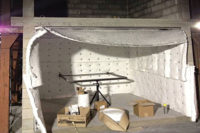
Wisconsin’s Lambeau Field is home to the Green Bay Packers and carries the distinction of being the National Football League’s longest continuously occupied stadium. With a staunch fan base, the facility has been sold out on a season-ticket basis since 1960.
For a variety of reasons, EPS (expanded polystyrene) rigid foam insulation was chosen as the primary insulation for the interior side of the exterior walls in a major expansion and remodeling project. The EPS sheathing or panel was specially designed with galvanized steel furring strips embedded directly into the foam plastic insulation with a polymeric laminate applied to each panel face.
H.J. Martin, the lead contractor in charge of gypsum wallboard on the Lambeau project, selected EPS over the original specification that called for a traditional three-step, on-site process of Z-furring, standard insulation panel installation and vapor barrier application.

EPS sheathing is applied during a major renovation of the Green Bay Packers’ Lambeau Field.
QUICK INSTALLATION
“We were looking for something faster than the typical process,” said Joel Johnson, project manager on the Lambeau project. “You also eliminate the extra step of having to add a vapor barrier, and you end up with a better R-value. I bet we saved 35 percent of our usual installation time.”It is estimated this design provides an overall project cost savings of approximately 20 percent and it delivers increased thermal performance because the embedded metal furrings never make contact with the masonry, virtually eliminating thermal bridging. The polymeric laminate provides a vapor perm rating of 0.07.
Sheathing is one of the most basic and widely used applications for rigid insulation in commercial construction. It helps create an envelope around the structure, covering wall cavities and studs to increase resistance to heat transfer and moisture penetration. Even though rigid foam plastic insulation was introduced into the construction market back in the 1950s, it was not used as sheathing with any prevalence until the energy crisis of the 1970s.
EPS sheathing is non-structural and is used as both an exterior and interior insulator, below and above grade, although it can be employed throughout the structure in roofs, floors, and ceilings. Manufacturers can also provide the builder with insulation that varies in density, possibly translating into a structure that meets–or exceeds–energy code standards without the added expense of increased stud width. When higher R-value is required, EPS can be fabricated to a higher density, rather than adding layers and layers of more rigid insulation materials.
Expanded polystyrene sheathing is compatible with framing made of traditional materials, along with masonry applications. The boards are installed vertically over the exterior sides of the studs, with the vapor retarder facing the heated side of the structure. Expanded polystyrene sheathing can be fastened with nails, screws, and/or staples, depending upon the framing surface. For example, spot adhesive is the norm for masonry substrates. However, it is important to note some adhesives contain petroleum-based solvents that will dissolve EPS on contact.
TAPED SEAMS, CORNER BRACES
The joints of EPS sheathing should be close and flush. Seams are taped for added tightness and corner braces are installed to increase structural stability. In some cases, air-barrier building-wrap may not be needed when the sheathing is properly installed and seam tape is used. A variety of sidings and finishes are easily affixed through the exterior sheathing to create an aesthetically pleasing building.Expanded polystyrene insulated sheathing board is manufactured with an array of facers. Aluminum foil, polyethylene, and kraft paper are all used to enhance performance properties and protect it from rough handling and ultraviolet degradation. Expanded polystyrene manufacturers use reflective aluminum foil to increase the resistance of radiant heat absorption. When a radiant barrier is combined with dead air space, it can actually add to the wall assembly’s insulation value.
Various EPS sheathing products are available depending on the intended application. One of the primary functions of sheathing is to help control moisture by acting as a vapor retarder. A perforated foil can increase breathability when used above-grade, thus assisting in the avoidance of any type of condensation build-up between the structure’s interior and exterior.
In addition to acting as a vapor retarder, polyethylene facers improve the surface adhesion of the board for taping and adhesives. The tape used to seal the seams of the foam plastic adheres better to the polyethylene-faced board rather than unfaced products. Kraft paper is bonded between the facer and foam plastic sheathing, increasing its strength and durability to provide additional protection during transportation and handling.
Expanded polystyrene has been used successfully for many years in areas where moisture is a concern, specifically below-grade. There had been some concern moisture would permeate voids existing between the foam plastic insulation and the wall cavity, causing damage. However, this theory was conclusively rejected after results were released from a study conducted by the National Research Council Canada (NRC). Below-grade EPS insulation performed consistently throughout the two-year study without signs of water damage to the structure or the EPS insulation.



